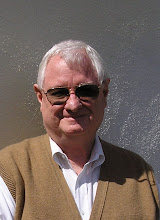Kioni Dudley led a fight against the Hoopili development
By Erika Engle
KIoni Dudley, a retired professor and high school teacher, led the battle against D.R. Horton-Schuler Hawaii in its bid to urbanize 1,500 acres of prime agricultural land in Ewa to build 12,000 homes in a community it calls Hoopili.
FL MORRIS / FLMORRIS@STARBULLETIN.COM
Kioni Dudley stands outside his home in Makakilo, which overlooks the rejected Hoopili project seen in the distance between the homes in the foreground and Pearl Harbor.
His Friends of Makakilo group, with backing from the state Office of Planning and the heads of the state Transportation and Agriculture departments, won a state Land Use Commission ruling rejecting the developer's plan.
Dudley does not claim a single-handed victory.
"We certainly have a good, large number of people ... working with us," he said. "They were not only members of Friends of Makakilo, but also concerned citizens from Ewa, Ewa Beach, Kapolei and the Waianae Coast.
"They were the people who went door to door and waved signs. They were the people who helped me in getting together town hall meetings and so forth," he said, naming Glenn Oamilda as well as his own wife, Doris Dudley -- "the super-organizer."
But the August decision ended just one battle.
The ruling was based on D.R. Horton-Schuler's failure to submit a plan detailing the timing, phasing and location of developing the community. Such detailed plans are required if a project will take more than 10 years to complete, and the Mililani- or Hawaii Kai-sized Hoopili development would take some 20 years.
"Obviously, we're disappointed in the decision," Horton President Mike Jones told the Star-Bulletin at the time. The developer vowed to push forward "to plan for the future of Hawaii, for future job growth and local housing."
There are currently 29,000 houses on the Ewa plain. Zoning has been approved for 33,000 more.
The additional 12,000 homes at Hoopili, on what is now prime farmland mauka of H-1, would require hauling away the rich topsoil and "filling up our farmland with coral so they can build their houses," Dudley said. "So it just plainly does not make sense."
The traffic problem is already huge, "and we're going to double the population out here and try to put them on H-1," he said. "Let's consider that for a minute."
Federal law will also require construction of "10-foot, solid concrete cement-block walls along the freeway in order to prevent the sound of the freeway from going in to Hoopili," Dudley said. "It's an urbanization of the country that is just unpalatable."
For Leeward-bound drivers, seeing the open space past Waipahu is good for the soul, Dudley said.
"If we allow Hoopili, it's going to cause solid houses from Hawaii Kai to Ko Olina, unbroken city," he said. "The Second City was supposed to be separate from the First City."
Friday, December 25, 2009
Subscribe to:
Post Comments (Atom)

No comments:
Post a Comment